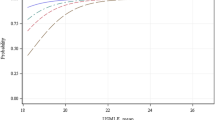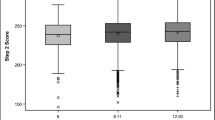Abstract
The Internal Medicine In-Training Examination (ITE) is administered during residency training in the United States as a self-assessment and program assessment tool. Performance on this exam correlates with outcome on the American Board of Internal Medicine Certifying examination. Internal Medicine Program Directors use the United States Medical Licensing Examination (USMLE) to make decisions in recruitment of potential applicants. This study was done to determine a correlation of USMLE Steps 1, 2 and 3 results with ITE scores in each level of Internal Medicine training. A retrospective review of all residents graduating from an Internal Medicine program from 1999 to 2006 was done. Subjects included had data for all USMLE Steps and ITE during all years of training. Thirty-one subjects were included in the study. Correlations of USMLE Steps 1, 2 and 3 were done with ITE scores (percent correct) in each year of training. Pearson’s correlation coefficient (r) was determined for each pairing and a t test to determine statistical significance of the correlation was done. Statistical significance was defined as P value <0.05. The r values for USMLE Step 1 and ITE percent correct in PGY I, II and III were 0.46, 0.55 and 0.51 respectively. Corresponding r values for USMLE Step 2 and ITE percent correct were 0.79, 0.70 and 0.72; for USMLE Step 3 these values were 0.51, 0.37 and 0.51 respectively for each training year. USMLE scores are correlated with ITE scores. This correlation was strongest for USMLE Step 2.



Similar content being viewed by others
References
Accreditation Council for Graduate Medical Education. (2008). http://www.acgme.org/acWebsite/reviewComment/140_internal_medicine_PRs_R&C.pdf. Accessed 29 May 2008. Chicago, IL: Accreditation Council for Graduate Medical Education.
American College of Physicians. (2008). http://www.acponline.org/education_recertification/education/in_training/. Accessed 12 Mar 2008. Philadelphia, PA: American College of Physicians.
Berner, E. S., Brooks, C. M., & Erdmann, J. B. (1993). Use of the USMLE to select residents. Academic Medicine, 68(10), 753–759.
Black, K. P., Abzug, J. M., & Chinchilli, V. M. (2006). Orthopaedic in-training examination scores: A correlation with USMLE results. Journal of Bone and Joint Surgery. American Volume, 88(3), 671–676.
Cacamese, S. M., Eubank, K. J., Hebert, R. S., & Wright, S. M. (2004). Conference attendance and performance on the in-training examination in internal medicine. Medical Teacher, 26(7), 640–644.
Carmichael, K. D., Westmoreland, J. B., Thomas, J. A., & Patterson, R. M. (2005). Relation of residency selection factors to subsequent orthopaedic in-training examination performance. Southern Medical Journal, 98(5), 528–532.
Daly, K. A., Levine, S. C., & Adams, G. L. (2006). Predictors for resident success in otolaryngology. Journal of the American College of Surgeons, 202(4), 649–654. Epub 2006 Feb 17.
Grossman, R. S., Fincher, R. M., Layne, R. D., Seelig, C. B., Berkowitz, L. R., & Levine, M. A. (1992). Validity of the in-training examination for predicting American Board of Internal Medicine certifying examination scores. Journal of General Internal Medicine, 7(1), 63–67.
Jones R., Panda M., Desbiens N. (2008). Internal medicine residents do not accurately assess their medical knowledge. Advances in Health Sciences Education: Theory and Practice, 13(4), 463–468.
McDonald, F. S., Zeger, S. L., & Kolars, J. C. (2007). Factors associated with medical knowledge acquisition during internal medicine residency. Journal of General Internal Medicine, 22(7), 962–968. Epub 2007 Apr 28.
Pohl, C. A., Robeson, M. R., & Veloski, J. (2004). USMLE Step 2 perofrmance and test administration date in the fourth year of medical school. Academic Medicine, 79(Suppl 10), S49–S51.
Taylor, C. A., Weinstein, L., & Mayhew, H. E. (1995). The process of resident selection: A view from the residency director’s desk. Obstetrics and Gynecology, 85(2), 299–303.
United States Medical Licensing Examination. (2008). http://www.usmle.org/Examinations/step3/step3_content.html. Accessed 17 Jun 2008. Philadelphia, PA: United States Medical Licensing Examination.
Author information
Authors and Affiliations
Corresponding author
Rights and permissions
About this article
Cite this article
Perez, J.A., Greer, S. Correlation of United States Medical Licensing Examination and Internal Medicine In-Training Examination performance. Adv in Health Sci Educ 14, 753–758 (2009). https://doi.org/10.1007/s10459-009-9158-2
Received:
Accepted:
Published:
Issue Date:
DOI: https://doi.org/10.1007/s10459-009-9158-2




